Although jiu jitsu has had different and strongly outlined grappling production lines from the moment it settled in Brazil, the word “system” was never part of the sport’s Portuguese speaking world. This changed as the martial art expanded into the United States and adopted the country’s glossary.
The relevance of this word goes well beyond linguistics, as more and more teams are understanding the importance of having a structured curriculum. One that outlines the core values and grappling ideology followed by each of the academy’s leaders. This is the case of the two teams with most affiliates in jiu jitsu (Alliance and Gracie Barra), who offer coach training courses and a curriculum to be followed by their franchises.
These various systems, or training methods often offer different solutions from one another when faced with similar problems which ultimately leads to the aforementioned identifiable athlete production lines. Athletes who we can yell out their lineage solely by watching them compete, without the help of patches or crowd chants.
One of those well outlined training methodologies is the one created by Ricardo Vieira, the leader of Checkmat who has produced several high level athletes such as Alan “Finfou”, Douglas Rufino, Sandro Vieira, Ary Farias, Jackson Sousa, Marina Ribeiro or Thiago Sá (to name a few), while having numerous future stars of the sport coming through the ranks, including Jonatas Gomes and the child prodigies Eduardo “Dudu” Granzotto as well as Jansen “Nenego”. All of which seem to play a very elusive, fast and athletic jiu jitsu style.
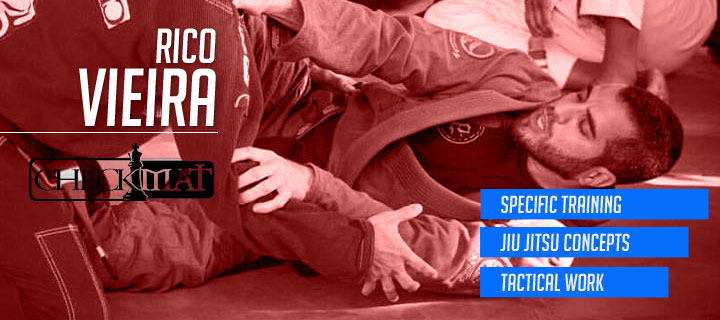
Ricardo’s coaching approach is unconventional. One of the first conceptualist coaches in the sport, Vieira does not focus on position details as per the majority of academies. In fact, more than often he skips this approach altogether to focus most of the work on position concepts, movement and tactics. Vieira is also knowledgeable in martial arts such as capoeira and kung fu, incorporating what he learnt from these styles’ movement philosophies to his methodology.
Known for his incredible spider guard as a competitor, a time when Vieira conquered 9 world titles (4 at black belt), Vieira stepped away from his comfort zone early on his coaching career. His guard training is often taught in concept blocks as well (control, distance and opportunity).
This methodology has led the athletes produced at Rio de Janeiro’s Fight Zone (Vieira’s headquarters) to come out very complete, with great spacial awareness, fluid jiu jitsu and active/mobile guard work that goes from single leg X, to Chin-on-Chin to Rico’s patented “Estilingue guard”. Always very tactically aware, though not often submission hunters.
Key Points From Vieira’s Training System:
- Specific Training (working From Set Positions).
- Tactical Knowledge
- Positional Concepts
Key Elements from Athletes Produced by Vieira’s system:
- Great at Keeping Control of the Distance
- Great at Scrambling
- Hard to Score on
- Complete Games
On the opposite side of the coaching spectrum are the Mendes brothers. Although still in their mid 20s the Art of Jiu Jitsu curriculum developed by Rafael and Guilherme Mendes is already regarded as one of the best in the world.
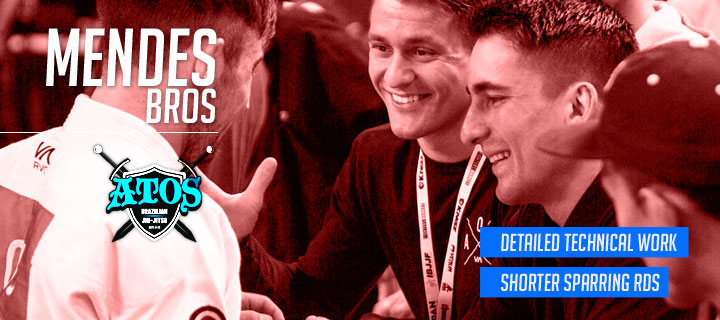
The Mendes’ system, much like their jiu jitsu style, is precise. Every inch counts and very few gaps are left to the interpretation of their pupils. This plan has developed the games of many high level athletes who travel from all around the globe to learn from the two brothers. Their list of students include Tammi and Mikey Musumeci, Caio Antonini, Nick Bohli, Rick Slomba and countess others, including arguably the best juvenile team in the world.
The academy is built on three learning blocks/classes: Fundamentals, Advanced and Competition. The Fundamentals Class is the core of the program with positions being taught to the more minute details. Advanced having less detailed instruction, going quickly over the techniques/drills in an attempt to improve timing and accuracy. And then the sparring, which more than often starts from standing. Finally the competition class, almost strictly dedicated to hard sparring.
One of the interesting aspects of AOJ’s teaching methodology is their sparing approach, in which the rounds can go in sets of 3, 4, 6 or 10 minutes, depending on the intent of the class.
Key Points From the Mendes’ Training System:
- Very Detailed Technique Tuition
- Hard Sparring From Standing
- Working Round Times According to Objectives
Key Elements from Athletes Produced by the Mendes’ system:
- Systematic (Connect Positions Extremely Well)
- Game Planners
- Meticulous
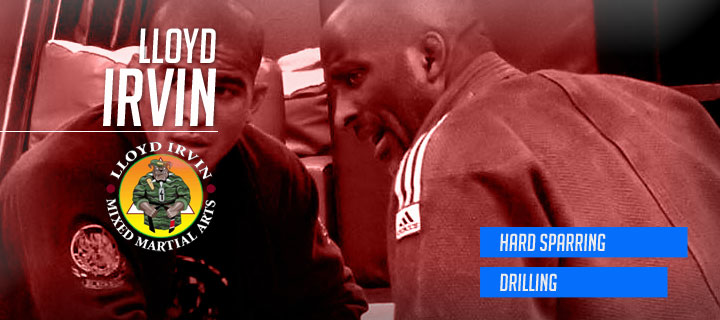
Arguably the most well defined style in jiu jitsu’s competition scene is that of Team Lloyd Irvin. TLI’s M.O. was defined on the backs of aggressive competitors with great throws/takedowns and a pressure based top game, while being also known for their enthusiastic supporters – men and women who have given us the famous “twooo!” referee plead, heard today all across the American circuit almost every time a ref is late to award sweeping/takedown points on a jiu jitsu mat.
Staying true to American East Coast tradition, Maryland’s own, TLI shows tremendous work rate, this being the backbone of the team’s success. Many who have experienced Irvin’s training sessions claim it to be the hardest working gym in the country where each of the athletes evolution is carefully followed by the team’s head instructor.
Another one of the core values that has often poured outside of Irvin’s private methodology, is a strong commitment to drilling techniques, allied with specific training and very hard sparring sessions which forged some elite jiu jitsu athletes such as Tim Spriggs, DJ Jackson, Willie Leonard, Mahamed Aly, Nyjah Easton and countless others.
Irvin’s vast no-gi knowledge has also transferred well down to his students, who find success in both aspects of jiu jitsu’s competitive landscape.
Key Points From Lloyd Irvin’s Training System:
- Drilling
- Well Versed Standing-up
- Balance Between Specific Training and Sparring (the latter always from stand-up)
Key Elements from Athletes Produced by Irvin’s system:
- Grinders
- Not often Flamboyant Guard Players But Excellent at Imposing Their Game Plan (i.e. The opponent may know what is coming, but he won’t be able to stop it)
- Pressure Based Top Game
- Good at Avoiding Danger
Another coach that seems to constantly produce high level athletes with a very personalized style is Romulo Barral – head coach of Gracie Barra Northridge. Throughout his incredible competitive career Barral was regarded as one of the best guard players of all time, and his knowledge has certainly been handed down to his students, who have just this year started to spawn into the black belt division, with immediate success. Competitors such as Edwin Najmi, Gabriel Arges, Pedro Araújo and (the more veteran) Felipe Pena; with plenty more monsters brewing in the lower ranks.
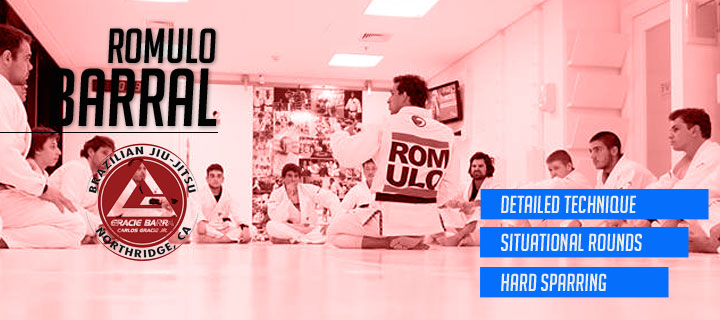
Barral keeps his training simple by showing detailed technique, situational/specific training and hard sparring. Though most of the pro team will drill positions, they do it in their own time, with the class being used to correct old/ add new techniques and sparring.
The specific training often serves a purpose, by working on competition circumstances. For example: Guard player on bottom is winning and will work solely on guard retention. He cannot sweep or submit while the student on top position will have 2 minutes to pass the guard.
Though this “situational” training will take place often, priority is always given to sparring, which will take most of the classes’ time. Barral’s training backbone is:
- Detailed Technique Tuition
- Situational Sparring Rounds
- Hard Sparring Sessions
Key Elements from Athletes Produced by Barral’s system:
- Unpassable Guards
- Highly Dynamic
- Submission Orientated
Lastly, one of the most thriving academies in the world: GF Team. Led by the legendary Mestre Julio César Pereira, GFT is arguably the most successful academy today at implementing a traditional jiu jitsu style at the highest level in a sport that is constantly pushing for a renovation of techniques.
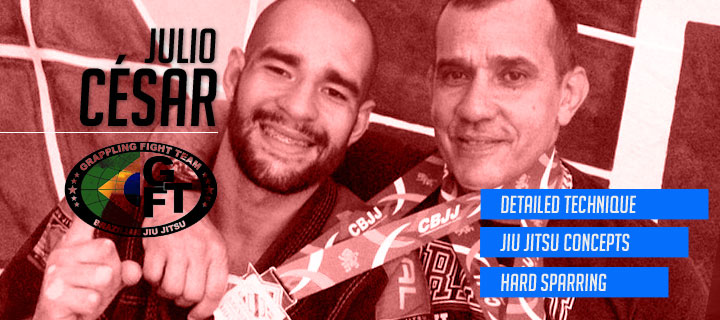
While the world keeps throwing new positions at them (berimbolo/ 50-50/ leg drag/ kiss of the dragon, etc), GFT and Master César continue to find simple solutions and implement their gameplan of solid fundamentals and heavy pressure, with some of the most effective closed guard experts in the world (Jaime Canuto, Ricardo Evangelista, Igor Silva, Vinicius Marinho, etc), and bulldozing guard passers (Rodolfo Vieira, Victor Oliveira, Victor Silverio, Max Gimenes, Gutemberg Pereira, etc) not to mention half guard wizards such as Jake Mackenzie and more recently Alex Tráns.
The system is simple, and precise. Julio Cesar teaches a 2 hour morning class, going over 3 to 4 positions thoroughly. Conceptual coaching is also utilized, when Master Cesar goes over certain circumstances, focussing on where to position the body and how to move correctly. After a lunch break the pro team will gather for another 2 hours, this time for one of the hardest sparring sessions on the planet, particularly on Mondays, Wednesdays and Fridays. Competitors are expected to do at the very least 10 rolls of 6 minutes, though many of the athletes will often do 20. Some drilling will take place 2 days per week, though the core of the training is the sparring.
Key Points From Julio Cesar’s Coaching System:
- Very Detailed Technique Tuition
- Positional Concepts
- Extensive Sparring (10 to 20 rounds of 6 minutes)
EDITOR NOTE: We received a few messages and emails complaining on why team “X, Y, Z” weren’t featured on this piece. Understand that this is not intended to be a “top 5” article. Just an explanation of the method applied by some of the sport’s top coaches. Also, this covers gyms who tend to produce a similar style of competitor.
Cover photo by Frederik Petersen, picture taken at Fightzone – London.
















It’s nice to know that many of these popular systems do emphasize starting standing for sparring. I understand that sparring from the knees is safer but it has made for a whole lot of jiu jitsu grapplers with a very weak stand up (grappling) game.